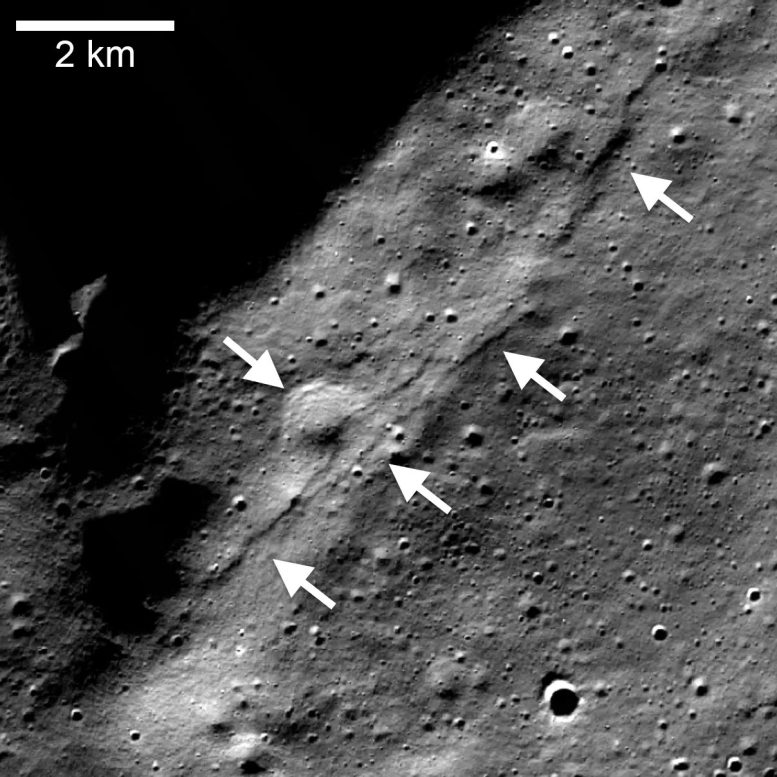The epicenter of one of the strongest lunar earthquakes recorded by the Apollo Passive Seismic Experiment is located in the lunar south polar region. However, the exact location of the epicenter cannot be determined precisely. A cloud of possible locations (purple dots and light blue polygon) of a strong shallow lunar earthquake is distributed using a transmission algorithm specially adapted for sparse near-pole seismic networks. The blue boxes show the locations of the proposed Artemis III landing zones. Lobed fault slopes are shown with small red lines. The cloud of epicenter locations includes a number of lobate cliffs and several Artemis III landing zones. Image source: NASA/LROC/Arizona State University/Smithsonian Institution
The new paper identifies potential landing sites for the Artemis mission that are particularly vulnerable to earthquakes and landslides.
Earth's moon has shrunk by more than 150 feet in circumference, as its core has gradually cooled over the past hundreds of millions of years. In the same way that a grape wrinkles when it shrinks into a raisin, the moon also wrinkles when it shrinks. But unlike the flexible skin on grapes, the moon's surface is brittle, causing imperfections to form where parts of the skin push against each other.
Lunar earthquakes and human exploration
A team of scientists has discovered evidence that this ongoing contraction of the Moon has led to noticeable surface warping in the Antarctic region, including areas where… NASA Proposed for manned Artemis III landings. Because rift formation caused by a shrinking Moon is often accompanied by seismic activity such as moonquakes, locations near or within these rift zones could pose risks to future human exploration efforts.
In a new paper published in Planetary Science JournalThe team linked a group of faults in the moon's south polar region to one of the strongest lunar earthquakes ever recorded Apollo seismographs For more than 50 years. Using models to simulate the stability of surface slopes in the region, the team found that some areas were particularly vulnerable to landslides triggered by seismic tremors.

Lunar Reconnaissance Orbiter Camera (LROC), narrow-angle camera (NAC) mosaic of the Wiechert group of lobate mantles (arrows pointing left) near the Moon's south pole. The fault slope cuts through a degraded crater about 1 km (0.6 mi) in diameter (pointing arrow to the right). Image source: NASA/LRO/LROC/ASU/Smithsonian Institution
The nature and dangers of lunar earthquakes
Thomas R. said: “Our models suggest that shallow lunar earthquakes capable of generating strong ground shaking in the Antarctic region are likely from strike-slip events on existing faults or the formation of new thrust faults,” said Dr. Waters, lead author of the study, a senior scientist emeritus at Harvard University. National Air and Space Museum Center for Earth and Planetary Studies. “The global distribution of emerging thrust faults, their ability to be active, and the potential for new thrust faults to form from ongoing global contraction must be taken into account when planning the location and stability of permanent lunar outposts.”
Shallow lunar earthquakes occur near the moon's surface, only a hundred miles or so deep in the Earth's crust. Similar to earthquakes, shallow lunar quakes are caused by faults in the moon's interior and can be powerful enough to destroy buildings, equipment, and other man-made structures. But unlike earthquakes, which tend to last only a few seconds or minutes, shallow lunar quakes can last for hours and even an entire afternoon — like the 5.0 magnitude lunar quake recorded by the Apollo Passive Seismic Network in the 1970s, and which the research team linked to the Seismic. A collection of errors recently discovered by the Lunar Reconnaissance Orbiter spacecraft.
Simulation of ground motion resulting from a shallow lunar earthquake located near the Moon's south pole. Strong to moderate ground shaking is expected at a distance of at least 40 km from the source. Credit: Nicholas Schmir, University of Maryland
According to Nicholas Schmer, co-author of the paper and associate professor of geology at the University of Maryland, this means that shallow lunar quakes could destroy hypothetical human settlements on the Moon.
“You could think of the Moon's surface as being dry and ground with gravel and dust. Over billions of years, the surface has been exposed by asteroids and comets, with the resulting angular fragments constantly being ejected from impacts,” Shamir explained. “As a result, the size of the reworked surface material can range from the size of a micron to The size of a rock, but all very loosely compact. Loose sediments make vibrations and landslides very possible.
Researchers continue to map the moon and its seismic activity, hoping to identify more sites that may pose a risk to human exploration. NASA's Artemis missions, which are scheduled to launch their first crewed flight in late 2024, hope to eventually establish a long-term presence on the moon and eventually learn to live and work on another world through observatories, outposts and settlements on the moon.
Preparing for Artemis missions
“As we approach the launch date of the crewed Artemis mission, it is important to keep our astronauts, equipment, and infrastructure as safe as possible,” Shamir said. “This work helps us prepare for what awaits us on the Moon, whether that's engineering structures that can better withstand lunar seismic activity or protecting people from really dangerous areas.”
The team's paper was published in Planetary Science Journal On January 25, 2024.
Reference: “Tectonics and Seismicity of the Lunar South Pole” by TR Watters, NC Schmerr, RC Weber, CL Johnson, EJ Speyerer, MS Robinson, and ME Banks, 25 January 2024, Planetary Science Journal.
doi: 10.3847/PSJ/ad1332
This research was supported by NASA's Lunar Reconnaissance Orbiter mission and the NASA SSERVI GEODES program (Award No. 80NSSC19M0216). This article does not necessarily reflect the views of this organization.

“Beer aficionado. Gamer. Alcohol fanatic. Evil food trailblazer. Avid bacon maven.”
